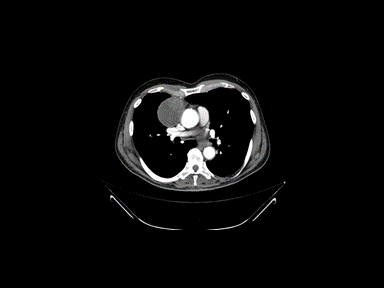Sandbox:Trusha: Difference between revisions
Jump to navigation
Jump to search
Trushatank (talk | contribs) No edit summary |
Trushatank (talk | contribs) No edit summary |
||
| Line 253: | Line 253: | ||
* [[Chest pain]] | * [[Chest pain]] | ||
* The positional change affecting the chest pain | * The positional change affecting the chest pain | ||
* Dyspnea or nonspecific chest | * Dyspnea or nonspecific chest discomfort | ||
* | * symptoms of infection, injury or systemic disease causing the effusion | ||
* | * | ||
| Line 260: | Line 260: | ||
| style="background: #F5F5F5; padding: 5px;" | | | style="background: #F5F5F5; padding: 5px;" | | ||
| style="background: #F5F5F5; padding: 5px;" | | | style="background: #F5F5F5; padding: 5px;" | | ||
| style="background: #F5F5F5; padding: 5px;" | | | style="background: #F5F5F5; padding: 5px;" | | ||
|- | |- | ||
| style="background: #DCDCDC; padding: 5px; text-align: center;" |[[Aortic dissection]]<ref name="pmid23225215">{{cite journal |vauthors=Juanpere S, Cañete N, Ortuño P, Martínez S, Sanchez G, Bernado L |title=A diagnostic approach to the mediastinal masses |journal=Insights Imaging |volume=4 |issue=1 |pages=29–52 |date=February 2013 |pmid=23225215 |doi=10.1007/s13244-012-0201-0 |url=}}</ref> | | style="background: #DCDCDC; padding: 5px; text-align: center;" |[[Aortic dissection]]<ref name="pmid23225215">{{cite journal |vauthors=Juanpere S, Cañete N, Ortuño P, Martínez S, Sanchez G, Bernado L |title=A diagnostic approach to the mediastinal masses |journal=Insights Imaging |volume=4 |issue=1 |pages=29–52 |date=February 2013 |pmid=23225215 |doi=10.1007/s13244-012-0201-0 |url=}}</ref> | ||
Revision as of 15:47, 6 February 2019
↑↓Editor-In-Chief: C. Michael Gibson, M.S., M.D. [2] Associate Editor(s)-in-Chief: Trusha Tank, M.D.[3]
- Bowel endometriosis vs Hemorrhoids vs Diverticular diseases vs Anal fissure vs Ulcerative colitis vs Crohn's disease,
- Superior vena cava obstruction
- Partial anomalous pulmonary venous connection
- Esophageal achalasia
- Esophageal cancer
- Esophageal rupture
- Hiatus hernia
- Hilar lymphadenopathy
- Pneumomediastinum
- Sarcoidosis
- Lymphoma
- Neurilemmoma
- Non-Hodgkin lymphoma
- Teratoma
- Thymoma
| Class | Disease | Sign/Symptoms | Risk factors | Gold standard | Image | Additional findings |
|---|---|---|---|---|---|---|
| Anterior mediastinal mass | ||||||
| Tumors | Thymoma |
|
|
Biopsy:
|
Associated condition
| |
| Fatty mass |
|
|
MRI:
|
Fatty mass can be:
| ||
| Non-Hodgkin lymphoma |
|
(HIV, Hep C, HTLV-1, EBV, HHV-8, H. pylori, psittacosis, Campylobacter jejuni)
(pesticides, methotrexate, TNF inhibitors, trichloroethylene)
|
Excisional lymph node biopsy with immunohistochemical study
|
| ||
| Teratoma | Benign
Malignant |
|
Chest CT scan:
|
N/A | ||
| Thyroid disease | Thyroid cancer[1] |
|
|
US guided biopsy: | TFT
| |
| Goiter[1] |
|
Radioactive iodine scan:
|
Hyperavtive gland (hyperthyroid):
Hypoactive gland (hypothyroid):
Normal functioning gland (euthyroid):
| |||
| Middle mediastinal mass | ||||||
| CVS disease | Pericardial effusion[1] |
|
||||
| Aortic dissection[1] | ||||||
| Superior vena cava obstruction[1] | ||||||
| Partial anomalous pulmonary venous connection[1] | ||||||
| GI disease | Esophageal achalasia | |||||
| Esophageal cancer | ||||||
| Esophageal rupture | ||||||
| Hiatus hernia | ||||||
| Pulmonary disease | Hilar lymphadenopathy | |||||
| Pneumomediastinum | ||||||
| Sarcoidosis | ||||||
| Mediastinal tumor | Mediastinal tumor | |||||
| Mediastinal germ cell tumor[1] | ||||||
| Infection | Mediastinitis | |||||
| Anthrax | ||||||
| Tularemia | ||||||
| Cystic disease | Dermoid cyst | |||||
| Bronchogenic cyst[1] | ||||||
| Chronic
inflammatory |
Churg-Strauss syndrome | |||||
| Posterior mediastinal mass | ||||||
| CNS disease | Meningocele[1] | |||||
| Neurilemmoma[1] | ||||||


References
- ↑ 1.00 1.01 1.02 1.03 1.04 1.05 1.06 1.07 1.08 1.09 1.10 1.11 1.12 1.13 Juanpere S, Cañete N, Ortuño P, Martínez S, Sanchez G, Bernado L (February 2013). "A diagnostic approach to the mediastinal masses". Insights Imaging. 4 (1): 29–52. doi:10.1007/s13244-012-0201-0. PMID 23225215.
- ↑ Molinari F, Bankier AA, Eisenberg RL (November 2011). "Fat-containing lesions in adult thoracic imaging". AJR Am J Roentgenol. 197 (5): W795–813. doi:10.2214/AJR.11.6932. PMID 22021525.
- ↑ Sandlund JT (2015). "Non-Hodgkin Lymphoma in Children". Curr Hematol Malig Rep. 10 (3): 237–43. doi:10.1007/s11899-015-0277-y. PMID 26174528.
- ↑ Armitage JO, Gascoyne RD, Lunning MA, Cavalli F (2017). "Non-Hodgkin lymphoma". Lancet. 390 (10091): 298–310. doi:10.1016/S0140-6736(16)32407-2. PMID 28153383.
- ↑ Yalagachin GH (June 2013). "Anterior mediastinal teratoma- a case report with review of literature". Indian J Surg. 75 (Suppl 1): 182–4. doi:10.1007/s12262-012-0569-6. PMID 24426558.
- ↑ No TH, Seol SH, Seo GW, Kim DI, Yang SY, Jeong CH, Hwang YH, Kim JY (September 2015). "Benign Mature Teratoma in Anterior Mediastinum". J Clin Med Res. 7 (9): 726–8. doi:10.14740/jocmr2270w. PMC 4522994. PMID 26251691.